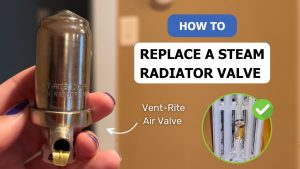Valves are mechanical devices installed into fluid systems that allow you to control, stop, and start fluid flow through an application. Ball valves and globe valves are two popular types of fluid control valves that close in different ways. Learning which valve type is the most suitable for your application can help you install the right one to ensure the seamless operation of your system.
What is a Globe Valve?
Globe valves are a type of control valve used to stop, start and regulate the flow of media through a pipe. From the outside, they have a spherical body design; inside, a plug-like disc sits on the end of a threaded rotating stem, which raises and lowers to control media flow. Globe valves are part of the linear motion valve family, which means that the valve mechanism moves along a straight line.
Globe valves provide a tight seal with low chances of leakage, which is why they are a common choice in high-pressure, industrial piping systems.
How does a Globe Valve work?
Globe valves were for many years the industry standard in control valves. They are named for their spherical body shape, with the two halves of the body being separated by an internal baffle. This has an opening that forms a seat onto which a movable plug (or disc) can be screwed in to close the valve. Typically, automated globe valves use smooth stems rather than threaded and are opened and closed by an actuator assembly.
Applications of Globe Valves
As an important component of aerospace equipment, the globe valve realizes the functions of medium transportation, cut-off, and adjustment. Its sealing performance directly affects the safe and reliable operation of the aerospace equipment. Studying the influencing factors and influencing laws of the sealing characteristics of typical globe valves has a guiding significance for the structural design of the valve sealing pair, thereby improving the sealing performance and reliability of the valve.
What is a Ball Valve?
Unlike gate or globe valves, ball valves are a type of quarter-turn valve that utilizes a bead shaped ball with a hole in the middle to control the flow of media. Called a bore or port, the hole in the middle of the ball allows media to pass through the valve body when opened, and is rotated 90 degrees to stop flow. The port is aligned perpendicular to the valve body in the closed position.
How does a Ball Valve work?
Ball valves are designed with a ball inside the valve. A ball valve is a form of quarter-turn valve which uses a hollow, perforated and pivoting ball (called a “floating ball”) to control flow through it. It is open when the ball’s hole is in line with the flow and closed when it is pivoted 90-degrees by the valve handle. The handle lies flat in alignment with the flow when open, and is perpendicular to it when closed, making for easy visual confirmation of the valve’s status.
Applications of Ball Valves
Ball valves are widely used in petroleum refining, long-distance pipelines, chemical industry, papermaking, pharmaceuticals, water conservancy, electric power, municipal administration, steel and other industries, occupying a pivotal position in the economy. It has the action of rotating 90 degrees, the cock body is a sphere, with a circular through hole or channel passing through its axis.
Ball Valve vs Globe Valve
There are many different types of valves available for different applications. With so much choice it can be difficult to decide which valve is most suitable for your application. In this article, BM Engineering Supplies explores the merits of ball valves versus globe valves.
Globe Valve vs Ball Valve
The main difference between ball and globe valves is the way they close. Ball valves have a stem and ball, which turns horizontally, and are commonly referred to as “rotational” valves. Whereas, globe valves have a stem and plug, which strokes linearly, and gives them their other name of “stroke” valves. Ball valves are best suited to applications requiring on/off control without pressure drop. While globe valves excel at regulating flow.
Which is better : a Ball valve or Globe Valve?
Ball valves are durable, performing well after many cycles, and reliable, closing securely even after long periods of disuse. These qualities make them an excellent choice for shutoff applications, where they are often preferred to gates and globe valves. On the flip side, ball valves do lack the fine control in throttling applications offered by globe valves.
| Pros | Cons | |
| Glove Valves | Can regulate media flow Can handle high-pressure, high-temperature, corrosive or viscous media Low chance of leakage | Create a high-pressure drop Introduce resistance to media flow |
| Ball Valves | Long lasting and durable Versatile media compatibility Compact Provide fast cycle speeds Good for high-pressure, high-volume applications Offer little resistance to media flow | Not ideal for regulating flow Fast cycle time can lead to water hammer |
Advantages of Ball Valves
- One of the easiest valves to operate with their simple quarter turn (90 degree) operation.
- Easy to visually confirm the status of the valve by the position of the handle. When the handle is parallel to the flow, it’s open and when it’s perpendicular, it’s closed.
- Have a low pressure drop and relatively high flow capacity.
- Can work well in high pressure and high-temperature applications.
- Robust construction with a long service life.
- Cost-efficient with low on-going maintenance costs.
- Easy to disassemble and the replacement of any worn parts is straight forward.
Disadvantages of Ball Valves
- Poor throttling capabilities, they’re primarily used in either the fully open or fully closed position.
- Not suitable for use on slurries or other thick liquids that can lead to the cavities around the ball and seats becoming “clogged” making operation of the valve difficult.
Advantages of Globe Valves
- Can be used for high-pressure and high-temperature systems, when design and materials permit..
- Good shutoff capability.
- Suitable for throttling and regulating flow due to their ability to be used in partially open positions.
- Their short travel stroke means fewer turns are required to fully open and close, saving time and wear on valve parts.
- Easy to maintain and resurface the seats.
Disadvantages of Globe Valves
- Requires greater force or a larger actuator to seat the valve.
- Low coefficient of flow resulting in a higher pressure loss across the valve in comparison to other “straight through” valve types.
Related Tags :
Ten articles before and after
How does the Globe Valve Operate?
Commendation Conference for National Response to Covid-19 Wholesaler
Features of Stainless Steel Ball Valve
Failure Analysis and Treatment of Stainless Steel Bellows Globe Valve
The 127th session of Canton Fair will be held from June 15th to 24th online
Advantages and Disadvantages of Gate, Butterfly, Globe, Ball, and Plug Valves(Part 2)
Advantages and Disadvantages of Gate, Butterfly, Globe, Ball, and Plug Valves(Part 1)












